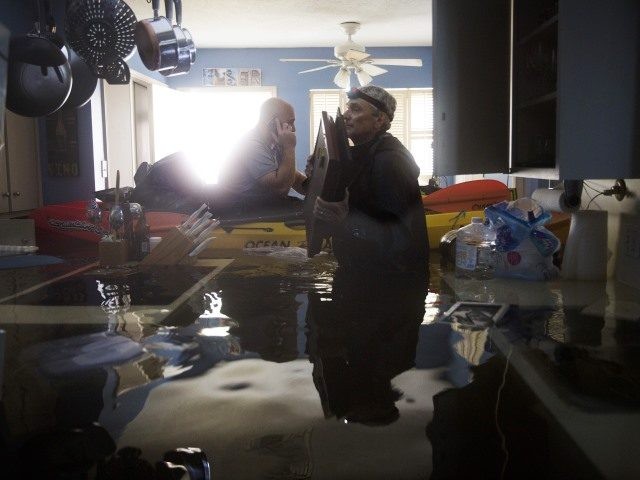The latest data from public health officials reveal that the Escherichia coli bacteria, better known as E. coli, tainted Hurricane Harvey’s raging floodwaters significantly in Houston and the surrounding affected regions.
Days after the storm’s torrential downpours subsided, Breitbart Texas reported that Texas A&M University tested samples of Houston area surface water, finding E. coli levels 125 times higher than is considered safe for swimming. The federal BEACH Act established bacteria thresholds to protect swimmers, according to the Environmental Protection Agency (EPA).
Since then, The New York Times paid for lab analysis on testing conducted by Baylor College of Medicine and Rice University in conjunction with the Houston Health Department. They uncovered E. coli contamination in the Houston Energy Corridor at four times the level that is considered safe for swimming. Standing floodwater inside one Buffalo Bayou home came in at levels 135 times those deemed safe.
Independently, Houston’s KPRC collected water samples from more than a dozen flooded areas. This included downtown Houston along Buffalo Bayou, inside and outside of a Clayton Homes public housing project, in west Houston near the Energy Corridor, and in east Houston, near the San Jacinto River. Their lab results also netted high levels of E. coli plus lead and arsenic. A flooded driveway they tested showed E. coli four times higher than safe swimming levels.
The findings did not surprise Houston’s Chief Medical Officer, Dr. David Persse. “There are many, many contaminants in the floodwaters both biological and chemical,” said Persse. “There’s dog stool. There’s raccoon stool.” He told KPRC: “Once the first toilet gets breached, there’s now human stool in there too.”
Lisa Montemayor, environmental investigator for Houston, examined wastewater samples taken between September 4 and 11. She told the Houston Chronicle the greater metro area experienced a deluge that overwhelmed the region’s infrastructure and flooded two major treatment plants.
“E. coli enters flood and surface waters from a number of sources including sewer back-ups, storm water runoff that carries bacteria from animal and pet waste, flooded wastewater treatment plants, and failing septic systems,” she stated.
The bacteria lives in the digestive tracts of humans and animals. Many of its varieties are harmless, says the Mayo Clinic; however, a person can get an infection when coming into contact with water or food contaminated by the fecal matter of humans or animals.
Montemayor said another agency found mercury in wastewater outside a home along the San Jacinto River. She pointed out such results were consistent with sewage back-ups and suggest other sources which she did not identify.
For the most part, Texas is in the clean-up phase of the catastrophic storm. Even so, Chris Van Deusen, spokesman for the Texas Department of State Health Services (DSHS) calls for residents to remain vigilant for the organism. On Friday, he told Breitbart Texas, “I think the major thing for people to recognize is that there is still a potential that bacteria, E. coli, and others, could be in the floodwater.”
He cites this as reason why public health officials continue to recommend people avoid contact with floodwater as much as possible “especially if they have any kind of open wound.”
Van Deusen advised, “If someone gets a cut or other wound while they’re in the water, they should get out and wash it thoroughly with soap and clean water as soon as possible and then, not expose that wound to the floodwater again.”
He underscored that if someone experiences any of the sign of infection (i.e., swelling, pain, discoloration, blisters). they should seek medical treatment.
Dr. Peter Hotez, dean of the National School of Tropical Medicine at Baylor College of Medicine told Breitbart Texas by email he believed the biggest threat from E. coli occurred “during the immediate evacuation period due to exposure to flood waters, or in the crowded conditions of evacuation centers.”
Meanwhile, Hotez cautioned about another looming threat, mosquito-borne disease. They breed in stagnant waters. The Aedes aegypti type, indigenous to Texas, carries illnesses like Zika, Dengue, Chikungunya, and West Nile Virus.
“I’m concerned about a possible rise in mosquito-transmitted virus infections, especially West Nile, which was an important problem following Hurricane Katrina in Louisiana and Mississippi.”
In the months following the 2005 hurricane that devastated New Orleans, the Centers for Disease Control and Prevention (CDC) recorded a two-fold spike in West Nile neuroinvasive disease (WNND), a more severe version of the virus fraught with neurological symptoms that may include disorientation, tremors, convulsions, paralysis, coma, and even death.
As of September 22, the state aerially sprayed nearly 6.4 million acres to mitigate the proliferation of mosquitoes and the viruses they transmit. Previously, Van Deusen told Breitbart Texas WNV remained of particular concern because of its prevalence in Texas. On September 20, the state confirmed 80 WNV cases for 2017, including three deaths. Of these, 36 were the milder West Nile Fever while 44 were WNND. Last year, DSHS reported 370 WNV cases and 18 deaths.
Follow Merrill Hope, a member of the original Breitbart Texas team, on Twitter.

COMMENTS
Please let us know if you're having issues with commenting.